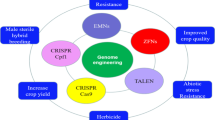Abstract
Cas9-based genome editing is a powerful genetic tool for loci specifically targeted for genome modification. This chapter describes up-to-date protocols using Cas9-based genome editing technology, including vector construction with GoldenBraid assembly, Agrobacterium-mediated soybean transformation, and identification of editing in the genome.
Access this chapter
Tax calculation will be finalised at checkout
Purchases are for personal use only
Similar content being viewed by others
References
Songstad D et al (2017) Genome editing of plants. Crit Rev Plant Sci 36(1):1–23
Gaj T, Gersbach CA, Barbas CF (2013) ZFN, TALEN, and CRISPR/Cas-based methods for genome engineering. Trends Biotechnol 31(7):397–405
Voytas DF (2013) Plant genome engineering with sequence-specific nucleases. Annu Rev Plant Biol 64:327–350
**ek M et al (2012) A programmable dual-RNA-guided DNA endonuclease in adaptive bacterial immunity. Science 337(6096):816–821
Feng Z et al (2013) Efficient genome editing in plants using a CRISPR/Cas system. Cell Res 23(10):1229–1232
Bayer PE et al (2022) Sequencing the USDA core soybean collection reveals gene loss during domestication and breeding. Plant Genome 15(1):e20109
Tanaka N et al (2020) Whole-genome sequencing of the NARO World Rice Core Collection (WRC) as the basis for diversity and association studies. Plant Cell Physiol 61(5):922–932
Sarrion-Perdigones A et al (2013) GoldenBraid 2.0: a comprehensive DNA assembly framework for plant synthetic biology. Plant Physiol 162(3):1618–1631
Thompson CJ et al (1987) Characterization of the herbicide-resistance gene bar from Streptomyces hygroscopicus. EMBO J 6(9):2519–2523
Gamborg OL, Miller RA, Ojima K (1968) Nutrient requirements of suspension cultures of soybean root cells. Exp Cell Res 50:152–158
Murashige T, Skoog F (1962) A revised medium for rapid growth and bioassays with tobacco tissue cultures. Physiol Plant 15:473–497
Michno J-M et al (2015) CRISPR/Cas mutagenesis of soybean and Medicago truncatula using a new web-tool and a modified Cas9 enzyme. GM Crops Food 6(4):243–252
De La Torre CM, Finer JJ (2015) The intron and 5′ distal region of the soybean Gmubi promoter contribute to very high levels of gene expression in transiently and stably transformed tissues. Plant Cell Rep 34(1):111–120
Zhang Z et al (1999) The use of glufosinate as a selective agent in Agrobacterium-mediated transformation of soybean. Plant Cell Tissue Organ Cult 56(1):37–46
Fehr WR, Caviness CE (1979) Stages of soybean development, vol 80. Cooperation Extension Service: Iowa State University, pp 1–12
Author information
Authors and Affiliations
Corresponding author
Editor information
Editors and Affiliations
Rights and permissions
Copyright information
© 2023 The Author(s), under exclusive license to Springer Science+Business Media, LLC, part of Springer Nature
About this protocol
Cite this protocol
Quach, T., Nguyen, H., Meyer, O., Sato, S.J., Clemente, T.E., Guo, M. (2023). Introduction of Genome Editing Reagents and Genoty** of Derived Edited Alleles in Soybean (Glycine max (L.) Merr.). In: Yang, B., Harwood, W., Que, Q. (eds) Plant Genome Engineering. Methods in Molecular Biology, vol 2653. Humana, New York, NY. https://doi.org/10.1007/978-1-0716-3131-7_17
Download citation
DOI: https://doi.org/10.1007/978-1-0716-3131-7_17
Published:
Publisher Name: Humana, New York, NY
Print ISBN: 978-1-0716-3130-0
Online ISBN: 978-1-0716-3131-7
eBook Packages: Springer Protocols




